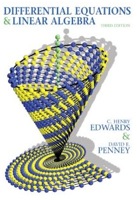
|
Differential Equations
2250-4 home page
|

|
Lecture notes will be posted by 4:00 p.m. the day before class. I strongly recommend bringing a copy of these notes to class, so we can go through the concepts and fill in the details together.
Week 1: January 9-13
jan9.pdf jan9.mw Introduction to course and Chapter 1.
jan10.pdf jan10.mw 1.2: differential equations of the form y'(x)=f(x).
jan11.pdf jan11.mw 1.2-1.3: slope fields and graphs of solutions to first order differential equations.
jan13.pdf jan11.mw 1.3-1.4: slope fields and the existence uniqueness theorem for IVP solutions, illustrated with separable differential equations.
Week 2: January 17-20
jan17.pdf jan17.mw 1.4-1.5; Toricelli experiment
jan18.pdf jan18.mw 1.5: first order linear differential equations
jan20.pdf jan20.mw 1.5 continued, and EP3.7 electrical circuits.
Week 3: January 23-27
jan23.pdf jan23.mw 2.1: improved population models
jan24.pdf jan24.mw 2.2: autonomous differential equations
jan25.pdf jan25.mw 2.2-2.3: applications of autonomous differential equations
jan27.pdf jan27.mw 2.3: improved velocity-acceleration models.
Week 4: January 30 - February 3
jan30.pdf jan30.mw 2.3: escape velocity
jan31.pdf jan31.mw 2.4-2.6: numerical methods for 1st order initial value problems.
numericaltemplate.pdf algorithms for Euler, improved Euler, and Runge Kutta.
feb1.pdf feb1.mw 3.1-3.2 linear systems of algebraic equations
feb3.pdf feb3.mw 3.1-3.3 Gaussian elimination and reduced row echelon form for finding the solution sets to linear systems of equations.
Week 5: February 6 - 10
feb6.pdf feb6.mw 3.3: deducing possible solution set structure from reduced row echelon form of the augmented and unaugmented matrices.
feb7.pdf feb7.mw 3.3-3.4 implications and applications using reduced row echelon form; matrix times vector algebra and consequences.
feb8.pdf feb8.mw 3.4-3.5 matrix algebra and introduction to matrix inverses.
feb10.pdf feb10.mw 3.5 matrix inverses.
Week 6: February 13 - 17
feb13.pdf feb13.mw 3.6:determinants
feb14.pdf feb14.mw 3.6:determinants and the adjoint formula for matrix inverses; Cramer's rule.
exam1review.pdf exam1review.mw for February 15.
feb17.pdf feb17.mw 4.1-4.3 introduction to concepts related to linear combinations of vectors and functions.
Week 7: February 21 - 24
feb21.pdf feb21.mw 4.1-4.3: linear combinations, span and independence.
feb22.pdf feb22.mw 4.1-4.4: vector spaces and subspaces.
feb24.pdf feb24.mw 4.4: bases and dimension.
Week 8: February 27 - March 2
feb27.pdf feb27.mw Key concepts and examples from 4.1-4.4
feb28.pdf feb28.mw 5.1 second order linear differential equations and connections to vector space concepts.
feb29.pdf feb29.mw 5.1-5.2 nth-order linear differential equations and connections to vector space concepts.
mar2.pdf mar2.mw 5.2-5.3 expanded discussion of linear independence for functions (5.2), and how to find the solution space for constant coefficient nth order linear homogeneous DEs (5.3).
Week 9: March 5 - 9
mar5.pdf mar5.mw 5.3 The solution space for constant coefficient nth order linear homogeneous DEs, when the characteristic polynomial has repeated and/or complex roots.
mar6.pdf mar6.mw 5.4 unforced mechanical oscillations.
mar7.pdf mar7.mw 5.4 unforced mechanical oscillations: pendulum model; mass-spring and pendulum experiments vs. predictions.
mar9.pdf mar9.mw 5.5 particular solutions to non-homogeneous linear differential equations
Week 10: March 19 - 23
mar19.pdf mar19.mw 5.5-5.6: variation of parameters for particular solutions. Applications of non-homogeneous differential equation theory to forced mechanical problems: undamped forced oscillations.
mar20.pdf mar20.mw 5.5-5.6, EP3.7 continued. damped forced oscillations and practical resonance in mechanical problems and in electrical circuits.
mar21.pdf mar21.mw 5.6, EP3.7 continued: using conservation of energy to find natural frequencies in single and multi-component systems.
mar23.pdf mar23.mw 10.1-10.2 Laplace transforms, and what they have to do with Chapter 5.
Week 11: March 26 - 30
mar26.pdf mar26.mw 10.1-10.3 Laplace transforms, and using them to re-solve the initial value problems for mechanical oscillations.
mar27.pdf mar27.mw 10.2-10.3 continued.
exam2review.pdf exam2review.mw Review of key ideas from 4.1-4.4, 5, EP3.7, 10.1-10.4, for the Thursday exam. Try to fill in details before class!
exam2reviewfilledin.pdf exam2reviewfilledin.mw cleaned up versions of how we filled in these notes during class.
mar30.pdf mar30.mw 10.4-10.5,EP7.6: further applications of Laplace transforms to differential equations.
Week 12: April 2 - 6
apr2.pdf apr2.mw 10.5, EP7.6 Laplace transforms for periodic function forcing, impulse function forcing, and why the convolution table entry is important in applications.
apr3.pdf apr3.mw 6.1-6.2: eigenvalues and eigenvectors for square matrices.
apr4.pdf apr4.mw 6.2: eigenspace bases and matrix diagonalizability.
apr6.pdf apr6.mw 7.1 systems of differential equations.
Week 13: April 9 - 13
apr9.pdf apr9.mw 7.1-7.3 systems of differential equations, theory and computations
apr10.pdf apr10.mw 7.3 The eigenvector method for solving homogeneous first order systems of differential equations. What to do about complex eigenvalues?
apr11.pdf apr11.mw 7.3 Solutions to non-homogeneous linear systems, as illustrated with a tank cascade.
apr13.pdf apr13.mw 7.4 undamped multi-component mechanical systems
Week 14: April 16 - 20
apr16.pdf apr16.mw 7.4 unforced and forced mechanical systems with several components
apr17.pdf apr17.mw 7.4 transverse oscillations and earthquakes shaking buildings. Also, introduction to Chapter 9.
apr18.pdf apr18.mw 9.1-9.2 autonomous systems of first order differential equations: phase portraits, equilibrium solutions, and linearization near equilibria.
apr20.pdf apr20.mw 9.2-9.3 classifying equilibrium solutions to autonomous systems of DEs, based on linearization. Applications to interacting populations.
Week 15: April 23 - 25
apr23.pdf apr23.mw 9.2-9.4 classification of equilibrium points, continued. Application to phase diagrams for nonlinear mechanical systems.
apr24.pdf apr24.mw 9.4 Phase portraits and stability analysis for first order systems arising from autonomous forced oscillation problems.
Math2250review.pdf Course review notes for Wednesday